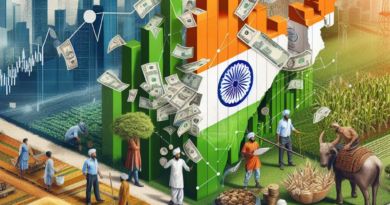Income Inequalities Hamper Sustainable Growth |Ias Banenge
Context:
In the current fiscal year, the Indian economy is anticipated to achieve a 7.6 percent growth in real GDP, building upon the impressive growth rates of 9.1 percent in 2021-22 and 7.2 percent in 2022-23. This trend, coupled with the Prime Minister’s commitment to robust economic reforms during his third term, has generated optimism among analysts for sustaining growth above 7 percent. However, there’s a significant caveat.
Relevance:
GS3- Indian Economy- Growth
READ MORE- Decoding the Judgment on Jim Corbett
Mains Question:
While the nation’s GDP is poised to surge by 7.6 per cent in the current financial year, concerns loom large over the sluggish pace of private consumption. Analyse. (10 Marks, 150 Words).
Growth in Private Consumption:
- Private consumption, which contributes a substantial 55 percent to India’s economy, has become a significant hindrance.
- For instance, it’s projected to grow merely by 3 percent in FY 2023-24, even lower than the initial estimate of 4.4 percent. This marks the slowest growth in private consumption since FY 2002-03, when it was at 2.9 percent.
- Sustaining an overall GDP growth of 7-8 percent in the coming years seems implausible if the primary component, private consumption, is expanding at less than half that rate.

What constitutes private consumption?
- In addition to fundamental necessities such as food, housing, clothing, education, and healthcare, private consumption encompasses expenditure on various discretionary items.
- These may include consumer durables like air conditioners, refrigerators, washing machines, televisions, automobiles, mobile phones, and the like.
- The demand for such goods is contingent upon the purchasing power of the populace, highlighting the importance of ensuring sufficient incomes for all working-age individuals (between 18 and 60 years old).
- This underscores another crucial aspect: the distribution of income and wealth.
Where does India stand in this regard?
- According to a report titled ‘Time to Care’ by Oxfam, released before the World Economic Forum’s Annual Meeting in January 2020, “India’s wealthiest one percent possess more than four times the wealth held by 953 million individuals constituting the bottom 70 percent of the population.”
- Additionally, the report revealed that India had a total of 63 billionaires, with their combined wealth surpassing that of India’s Union Budget for the fiscal year 2018-19.
- Another Oxfam report, “Inequality Kills,” issued prior to the WEF meeting in early 2022, indicated that the number of Indian billionaires rose to 102 by March 2020 and further increased to 142 by November 2021.
- During this period, their collective wealth surged from Rs 2.3 trillion to Rs 5.3 trillion. Concurrently, the income of 84 percent of households witnessed a decline, while the share of the bottom half of the population in national wealth remained a mere six percent.
- In contrast, a report titled “Survival of the Richest,” unveiled by Oxfam International during the 2023 annual gathering of the World Economic Forum in Davos, Switzerland, underscores that “the wealthiest one percent of individuals in India control over 40 percent of the nation’s total wealth.”
- When juxtaposed with the bottom half of the population receiving a mere six percent of the nation’s wealth, it exposes stark inequalities.

How does this imbalance affect demand?
Analysing Reports by Oxfam International:
- Let us consider India’s population of approximately 1.4 billion and nominal GDP of around Rs 300 trillion. Applying Oxfam’s percentages to these figures reveals significant disparities.
- The wealthiest one percent, comprising 14 million individuals, command 40 percent of GDP, equivalent to Rs 120 trillion, while the vast 50 percent of the population, numbering 700 million individuals, possess a meagre six percent of GDP, amounting to Rs 18 trillion.
- On a per-person basis, those in the wealthiest category boast an annual purchasing power of Rs 8.5 million each, whereas individuals in the bottom 50 percent have a purchasing power of a mere Rs 25,000 each.
- This distribution of income is far from conducive to fostering sustainable demand. There are inherent limitations to how much a wealthy individual can consume.
- Conversely, redistributing a significant portion of their wealth among those less fortunate, namely the bottom 50 percent, would substantially bolster private consumption.
- Amidst the clamor for policy reforms, tax reductions, and direct income support from various sectors, there’s a conspicuous absence of inquiry into the root causes of income disparities.
Examining BSE Constituent Companies:
Disproportionate Surge in Profits:
- An examination of the financial performances of India’s largest companies, as indicated by the BSE 500 index constituents, sheds light on this issue.
- Between FY 2017-18 and FY 2021-22, the profits of corporations within this index soared from Rs 4.8 trillion to over Rs 10 trillion, marking a staggering 100 percent increase, while their revenue growth only reached 47 percent during the same period.
- This indicates a deliberate containment of payments to factors of production beyond capital owners (i.e., shareholders), such as wages, input purchases, and interest payments, resulting in a disproportionate surge in profits.
High Payout Ratio:
- The collective dividend payout by these firms surged from Rs 1.76 trillion in FY 2017-18 to Rs 3.02 trillion in FY 2021-22, reflecting a 72 percent increase.
- Over the past five years, they consistently allocated at least 30 percent of their aggregate net profit as dividends, cumulatively distributing 34 percent of profits as dividends.
- This notably high payout ratio surpasses even that of the world’s largest companies listed in America’s S&P 500, indicating a lack of substantial reinvestment of profits for growth.
Creating the Transformative Impact on Demand:
- Whether these exceptional profits accrue to the companies or substantial dividends enrich shareholders, they do so at the expense of others.
- For instance, the Rs 10 trillion profits earned by BSE 500 index firms in FY 2021-22 came at the cost of eroding the purchasing power of millions of consumers.
- If even half of this amount, Rs 5 trillion, had been retained by consumers, aggregate demand would have seen a significant surge.
- Similarly, consider the Rs 3.02 trillion dividend disbursed to shareholders in FY 2021-22, with a significant portion flowing to promoters and other minority shareholders.
- If, instead of accumulating wealth, which often adds to their cash reserves or funds discretionary purchases, a greater portion were allocated to augmenting employee salaries, especially at lower levels, one can envision the transformative impact on demand.
- Numerous enterprises wield significant pricing power. For instance, those in the metal sectors like copper and zinc, or in hydrocarbons such as oil and gas, benefit from inherent market monopolies, enabling them to command high prices and thus reap windfall profits.
- Similarly, businesses in chemical, petrochemical, pharmaceutical, and agrochemical sectors thrive in protective policy environments.
- Moreover, over 60 million small and medium enterprises (SMEs) tend to emulate larger counterparts in wealth distribution practices. However, they often prioritize minimizing expenditure on worker remuneration.
Conclusion:
In essence, all businesses are structured to concentrate income in the hands of owners or influential entities. Instead of deflecting responsibility to the government, they must instigate fundamental operational changes. This entails tempering profit-driven zeal, moderating consumer charges, amplifying worker compensation, and contributing more to tax revenues.




